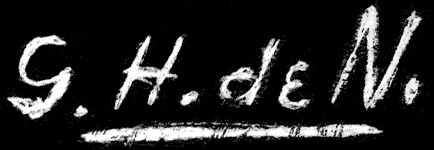

64th annual Spring Exhibition -Museum of Fine Arts - Art Association of Montreal (juried)


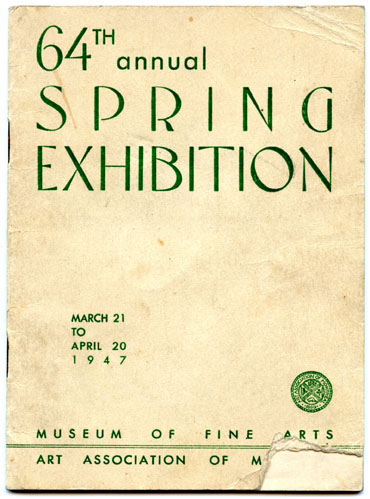
| Nature Morte | oil | ||||
| Nocturne | etching |
65th annual Spring Exhibition -Museum of Art - Art Association of Montreal (juried)


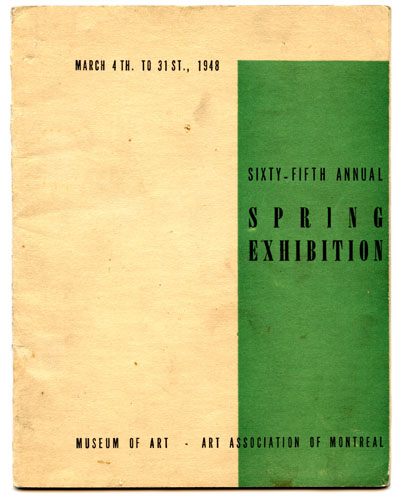
| Femme a l'Oiseau | oil |
66th annual Spring Exhibition -Montreal Museum of Fine Arts (juried)


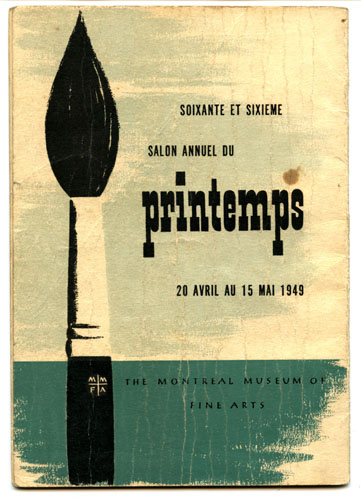
| Femme avec Nature Morte | oil | ||||
| Interieur | oil |
68th annual Spring Exhibition -Montreal Museum of Fine Arts (juried)


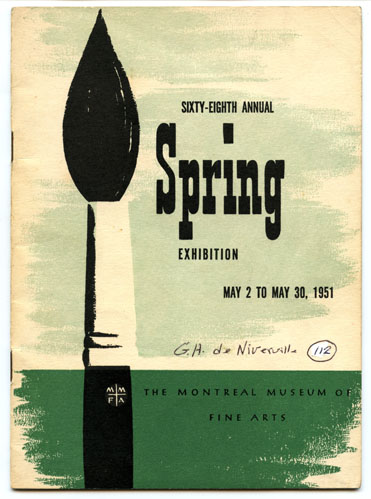
| Numero 6 | oil |
5th Biennial Exhibition of Canadian Painting -traveling exhibit organized by The National Gallery of Canada
6th Biennial Exhibition of Canadian Painting -traveling exhibit organized by The National Gallery of Canada
Joint exhibition with Duncan DeKergommeaux -National Gallery of Canada


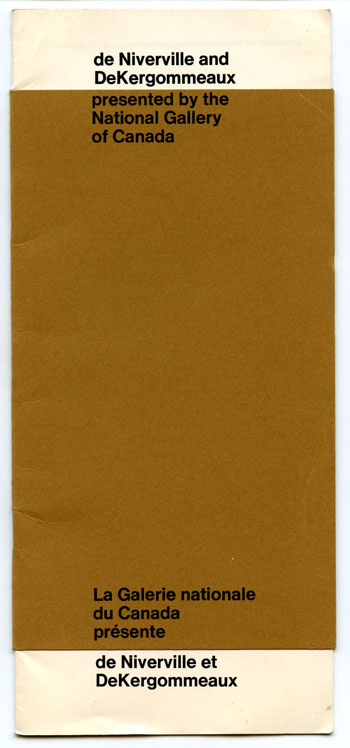
| The General | 48" x 60" | acrylic on masonite | |||||
| Ottawa Summer | 48" x 60" | acrylic on masonite | |||||
| Seated Nude | 48" x 72" | acrylic on masonite | |||||
| Homage to H F S No. 2 | 48" x 48" | acrylic on masonite |  | ||||
| The Triumphal Return | 48" x 66" | acrylic on masonite |  |
The Kingston Spring Exhibition of Art Sponsored by the Gallery Association of the Agnes Etherington Art Centre (judged)


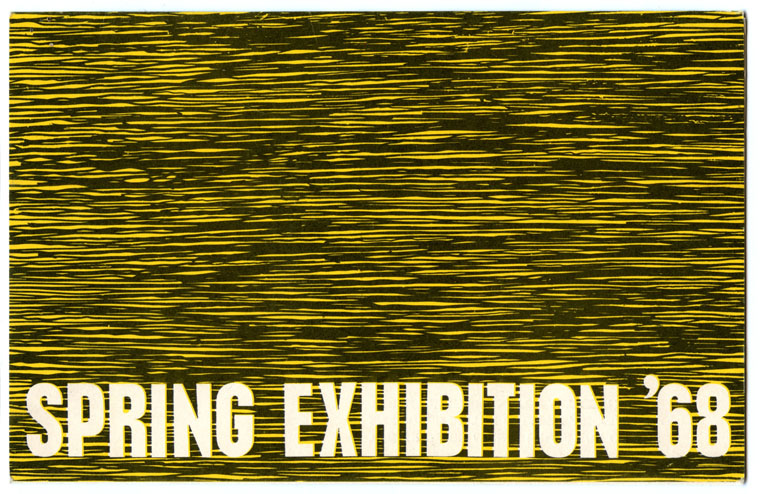
| The School Inspector | acrylic |
Solo exhibition at the Lofthouse Galleries


| Labor Leader | acrylic | ||||
| Chairman of the Board | acrylic | ||||
| An Intimate View of Brother Crapula | acrylic | ||||
| The Madwoman of St.-Pie de Bagot | acrylic | ||||
| ...and others |
Niverville exhibition reveals talent behind the station breaks
Every day, thousands of Ottawa area residents see the artwork of Georges de Niverville, 40, on CBOT-TV station breaks.
Few, if any, know the name of the Ottawa-born CBC graphics artist, much less the esteem in which he is held by the art community.
In his latest exhibition, ending Feb. 21 at the Lofthouse Galleries, 23s McLeod St., Mr. de Niverville continues his nostalgic, Bonnie and Clydeish evocation of his family's early days (1910-30).
In two paintings, he reflects his love of antique automobiles - he drives a late-model Morgan - and in three others, his fascination for men of power (the Labor Leader, Chairman of the Board and An Intimate View of Brother Crapula).
Brother Crapula is intimate, not only because he is nude except for a crucifix and wire-rimmed glasses, but also because of his knowing, almost -lecherous, smile.
The background is one solid color, as in many of Mr. de Niverville's paintings. The face, collar, shirt- front, a hand will emerge from the solid color of the painting.
De Gaulle flavor
Labor Leader, with dark glasses and a white scarf, smiles prosperously from an olive background.
On a bright red background, Chairman of the Board, calling de Gaulle to mind, has a bright white shirt, black bow tie and an aura of power.
Mother as a little girl and young woman, Aunt Alice in winter and spring and father beside his bright, yellow car - not to mention "family visitor" also identified as The Madwoman of St.-Pie de Bagot - all are painted from snapshots in the de Niverville family album.
The exhibition features 14 acrylic paintings and five charcoal drawings, all done in recent months.
Mr. de Niverville is known among friends for his sophisticated civilized Iove of life and his paintings reflect this.
Timeless quality
His use of a mist effect over the faces of his power figures produces what J. W. Borcoman, the National Gallery's education director, described as Mr. de Niverville's "poetic ambiguity", the subtle blurring of a mainly - concrete portrait-type of painting.
This technique gives the paintings a timeless, abstract quality - reflecting Mr. de Niverville's refusal to tie his paintings to particular persons, his invitation to viewers to take what they will from his paintings.
His great achievement is to communicate in terms of people without losing his jealously-guarded individualism, without falling into well-worn artistic groove.
The son of an RCAF air vice-marshal and brother of a successful artist, Louis de Niverville, Georges de Niverville was born in Ottawa and educated here - between air force postings.
He studied at the Montreal Museum of Fine Arts school of art and design under Arthur Lismer, Goodridge Roberts and Jacques de Tonnancour (1945-49) and at the Academie Ransor, Paris, under Singier, Manessier and Goetz (1953-55).
His exhibitions have been held in Montreal, Ottawa, Toronto, London and Paris. He is unmarried.
Joint exhibition with James Boyd, at Wells Gallery


| In His Own Car | acrylic | ||||
| Prefect of Discipline | acrylic | ||||
| Florida Vacation | acrylic | ||||
| Master of Ceremonies | acrylic | ||||
| ...and others |
Wells Gallery exhibits feature prints, paintings
Prints and paintings by James Boyd and Georges de Niverville are on show at the Wells Gallery, forming in effect two separate exhibitions.
The ground-floor gallery is occupied by acrylics from Georges de Niverville, a handsome selection of recent work, calm, lean and awesomely mature.
De Niverville does great things with paint, constantly reminding the viewer that it is paint while informing him of all the needs and links between ground and subject - if indeed they can be separated.
His color is restrained and satisfying, while throughout the work one is aware of the fact that room has been left for the viewer - something is needed from him, as well as the firm guidance of the artist.
In His Own Car, for example, a blackly-yellow ground becomes the mudguards and hood of an open sports car; every shape is there but painted in the same color.
The car's exuberant joyful yellowness has enveloped everything, a half-mechanical, half-living presence of which the driver has become part.
One remembers the wild enthusiasm of Toad of Toad Hall, where life itself, for a while becomes this fabulous possession.
His portraits are masterpieces of personality: look at the Prefect of Discipline, with his unpleasantly scrutinizing eyes - rather a give-away in such a seeming ascetic - and miserable, ungiving mouth; at the open pleasure of the Florida Vacation, all jollity and well-fed relaxation; and the pleasant formality - and iron control - of the Master of Ceremonies.
Landscapes are airy, wide, real "landscapes", emphasizing the awareness of solid, spreading earth and thin, limitless skies.
Through a completely blank, featureless foreground and a visual concentration of the sky immediately above the focal point of each work de Niverville again guides the viewer to an almost effortless contemplation of the three "elements" of his landscapes - air, earth and those things which lie between.
A series of 28 untitled prints by Jim Boyd completes the exhibition on the second floor. Silk-screen, embossed plates and etching techniques are all employed in a theme which seems partly designed to emphasize the unique properties of his medium, with the ability to repeat being used, explored, even exploited.
The same bearded figure of a man appears constantly, alone or in series, overlaid with writing reversed, enlarged, set upon an embossed grid or handled almost as a portrait.
The exhibition continues at 459 Sussex Drive until April 14.
Joint exhibition with Louis de Niverville, at The Wells Gallery


Joint exhibition with James Boyd, at Wells Gallery


| Standing Man | 63" x 28" | Charcoal | |||||
| Girl with Glasses | 28" x 23" | Charcoal | |||||
| Man with Tie | 27" x 24" | Charcoal | |||||
| Seated Man | 30" x 25" | Charcoal | |||||
| Standing Woman | 48" x 28" | Charcoal | |||||
| Woman with Glasses | 22" x 18" | Charcoal | |||||
| Leaning Man | 38" x 25" | Charcoal | |||||
| Man with Cigarette | 60" x 40" | Charcoal | |||||
| Man with Cane | 40" x 24" | Charcoal |  | ||||
| The Ball | 38" x 28" | Charcoal |  | ||||
| Woman with Tie | 24" x 20" | Charcoal | |||||
| Woman with Large Hat | 24" x 20" | Charcoal |
Powerful imagery in dual exhibit
According to James Boyd they've been together before but "Georges was always downstairs and I was up in the bedroom".
Now Georges de Niverville and James Boyd are together -on the ground floor - in the current exhibition at Wells Gallery. They may share the same space, may even share a similar zany sense of humor, but essentially Boyd and de Niverville are on completely different planes as artists.
Here are two artists, one working in dramatic startling colors, the other in charcoal. One manipulates a wealth of materials to form a single image, the other creates a wealth of images from a single material. One is totally abstract, the other surreal. Jim Boyd and Georges de Niverville.
It's a deceptive show. The size and imagery of both artist's work hits one immediately; yet Boyd and de Niverville have only supplied a dozen or more works apiece.
In a sense these two strong artists overpower not only one another but the viewer as well. In the long run, however, de Niverville's emphatic visions contain more energy, more social comment, more spontaneity than Boyd's.
That is not a statement I can make a lightly having, over the years, viewed, de Niverville with a certain amount of suspicion. I still find his paintings rather rigid for the kind of mood, of humor, he is trying to impart in his art. Charcoal, for de Niverville, is the perfect medium; it allows him to revel in his sketchy vision of reality while maintaining the size and scope of a major painting.
His nude Standing Man, when compared to a similar oil work shown at the Wells last year, is more dynamic, more ridiculous in his stockinged feet and gold-rimmed glasses.
James Boyd has based his recent work on a book entitled Investigating the Crack in the Cosmic Egg, recommended to him by National Gallery chief curator, Brydon Smith.
"Anyone," says Boyd, "can draw a perfect egg simply by holding one arm rigid and drawing in a wide arc. The egg is the basis of everything from sex to religion - it is a repression shape. You just have to look at a toilet seat to remember bad toilet-training."
An inveterate collector of other people's junk, Boyd has combined chicken wire, furnace screens, pop bottle snap tops, plastic sheeting, a chunk of car rust, medals and a huge cog in some automobile's wheel as the basis for his deep-relief forms. They appear and reappear in different hues and positions, in his celebration of The Egg.
It makes for fascinating, rather compulsive viewing -yet one finds oneself more trapped by the media than the message. Jim Boyd is a consummate craftsman in the print field, but occasionally one longs for more.
Recent works by James Boyd and Georges de Niverville will continue at the Wells Gallery, 459 Sussex Dr. until May 26.
Boyd and de Niverville at the Wells: -intriguing, challenging, puzzling
It is constantly amazing how artists have the power to excite us and disturb us at the most subtle levels. James Boyd and Georges de Niverville arc sharing the walls of the Wells Gallery at the moment in an exhibition of monoprints and charcoal drawings where each artist is seen alternately, a monoprint by Boyd, a charcoal drawing by de Niverville, all around the Gallery. The drawings are portraits of different people, at first glance recognizable and realistic, where Boyd's monoprints are colourful, busy, abstract, with many of the same elements reappearing again and again. Between Boyd's complex and almost cluttered visions, de Niverville's drawings look infinitely composed and orderly, but we may wonder whether he has simply taken a stronger grip on chaos, and tightened it more than Boyd has.
Boyd's prints are laid out like sheets and surfaces one on top of another. First a background; often two different-coloured sheets of what looks like old paper, torn or ragged at the edges, so you see little pieces of white showing through. Then screens: wire screens from screen doors, a tin sheet of circles from a furnace filter, wire mesh, a doily, in the middle often a circular machinelike form in Bristol blue. Occasionally in the centre an imprint of a religious medallion, an image of Christ with the Sacred Heart prominent on his chest. Sometimes a series of little circles forms a vague heart shape in the centre. The colours arc brilliant, vibrant: bright blue, orange, yellow, purple, red. Some of the surfaces look as though they were scratched with writing or printing centuries ago, their messages worn down with time (though I did make out the phrase "Nothing to do with the Group of Seven"). From a distance, the prints have the look of colourful icons, mandalas, emblems. At close range their busy textured surfaces suggest something of controlled chaos, like a dream landscape cluttered with tiny obstacles that you can't quite identify. One of the prints, Peaking into the Bowl, has two round shapes placed above the rectangular screens, and from a distance, it looks vaguely like two people standing one behind the other, holding the screens up (two little red shapes at each side suggest hands) for us to look at. Is the artist hiding behind these multiple, textured layers and hidden messages? Or is there no message other than the bright, vibrant colours and pitted surfaces, the metal screens, the vanishing printed letters and syllables?
With de Niverville's charcoal portraits, our thoughts move to a different plane: who are these people never identified - are they friends of the artist, or imaginative creations? Occasionally they look like caricatures, at other times like authentic portraits. Is the girl with the ball retarded, is the man with a cane deliberately shrunken to caricature? Who is the large gentleman with the Louis XIV wig and the 17th-century English costume, sitting smoking a cigarette and holding in one hand a pair of horn-rimmed glasses? Who is the tubby businessman standing naked, wearing only woolen socks and a wristwatch? Who are the ladies with large handsome Victorian hats? Who is the handsome gentleman with a moustache, turning to look at us from a chair? Do these people know each other? They are never shown in a context; do they exist? Both de Niverville and Boyd arc superbly in command of their craft, and both can be seen and enjoyed as experienced expert craftsmen, but they are also artists, and both of them, in different ways, conceal, and expose. They create different ambiguities; they ask different questions. This is one of the most intriguing and ambivalent shows that I've seen in a long time in an Ottawa Gallery. It opens itself to questions; it engages the senses; it puzzles the mind. You should see it for yourself; it will be at the Wells Gallery until May 26.
Joint exhibition with James Boyd, at Wells Gallery


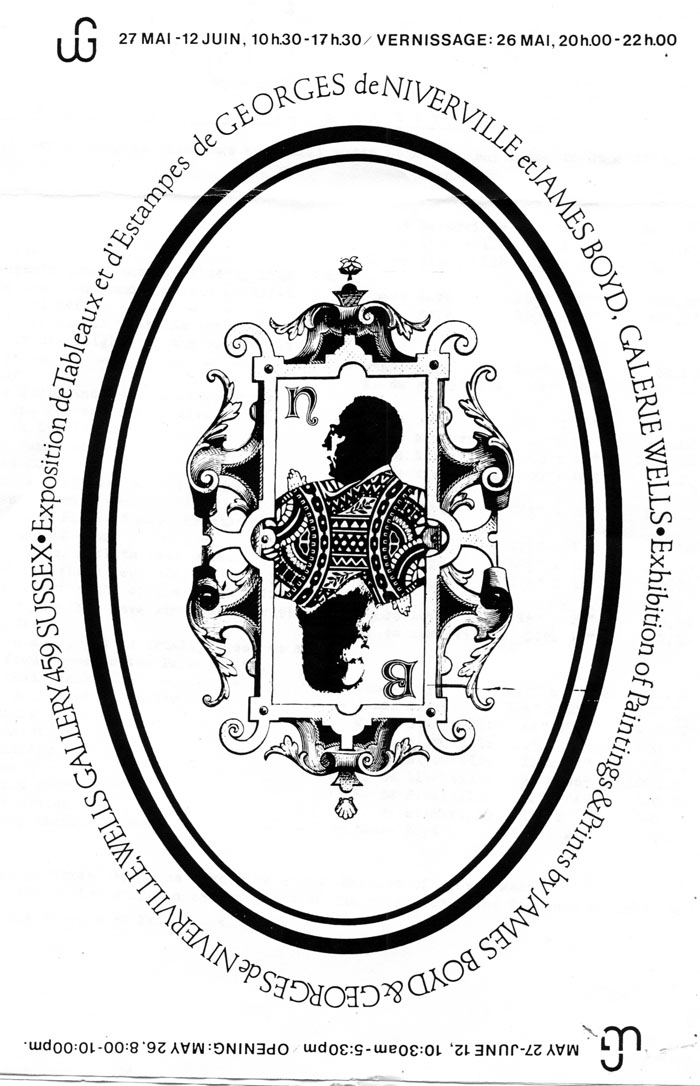
| Oval Lanscape | 48" x 42" | ||||
| Seated Man | 48" x 60" | ||||
| By The River | 22" x 35" | ||||
| Rainy Day | 28" x 22" | ||||
| Woman with Little Dog | 30" x 24" | ||||
| Man with Sunglasses | 48" x 42" | ||||
| The White Coat | 30" x 24" | ||||
| Standing Man | 84" x 48" | ||||
| Man Climbing | 48" x 36" | ||||
| Summer Landscape | 18" x 22" | ||||
| Fall Landscape | 13" x 23" | ||||
| Cloudy Day | 24" x 36" | ||||
| Approaching Storm II | 15" x 24" | ||||
| The White Collar | 13" x 16" |
History of Art and Artists of Ottawa and Surroundings, 1790-1970 : Part III, 1946-1970 -at Ottawa Art Gallery